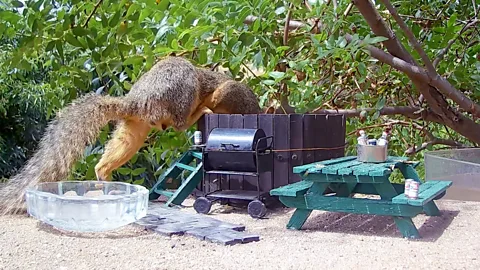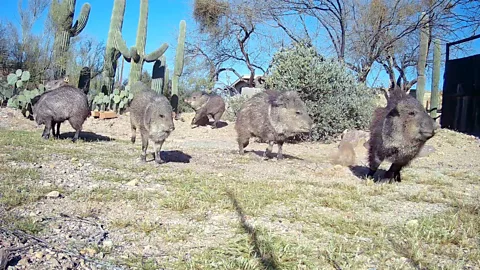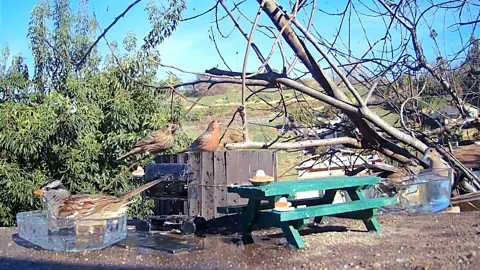An online community has erupted around people filming wildlife with backyard trail cameras, complete with dollhouse furniture film sets. It’s not just cute: the videos are uncovering animal secrets for biologists.
Growing up in Los Angeles, I mostly ignored nature. “I’m a city person” I’d say to anyone who tried to drag me on a hike. But during lockdown, I noticed finches nesting on my balcony. I hung bird feeders and downloaded an app to ID bird calls, hoping for something to keep me away from doomscrolling.
The finches made for a soothing distraction, but things really changed when I spotted a cute “critter cam” account on social media. People weren’t just feeding birds, they were filming them – even setting out a tiny hot tub for the birds to splash around in.
I became obsessed. I bought a generic trail camera on Amazon to put in my yard. In a matter of days, I’d plunged into the lives of my neighbourhood skunks, squirrels and possums, a nature-made reality show unfolding in the bushes of my own garden.
Depending on where you live, there’s probably a whole parallel universe of animal life right outside your window. All it takes is a little spy craft, and thanks to the proliferation of cheap cameras, a bustling population of critter enthusiasts has emerged online.
But this growing body of at-home wildlife footage is good for more than a quick hit of cuteness-driven dopamine. The animal videos people are sharing on social media are shifting perceptions about urban wildlife, fostering supportive communities and even impacting conservation efforts.
“My game cams bring me closer to the animals with whom I share this ecosystem,” says Eric Aldrich, who runs an at-home trail camera account from his home in Tucson, Arizona. “And when I share what my cameras capture with others – on social media, in meeting halls, in the desert and the mountains – my human neighbours feel closer, too.”
From online hobbyist to citizen science
On his half-acre of land that borders a dry watercourse, Aldrich has three solar-powered trail cameras. Originally popularised by hunters and researchers, trail cameras have infrared light motion sensors that are triggered, ideally, when an animal walks past. “I set mine to the highest-quality video setting and keep my [motion] sensitivity low because I don’t want blades of grass or a bug setting it off,” Aldrich says.
Once a month, Aldrich reviews the footage and edits together a narrated video that he shares on YouTube, Instagram and in a trail camera Reddit group. The regular cast of characters include packs of peccary – an herbivore that resembles a wild boar, also known as a javelina – deer, rabbits, coyotes, quail and nectar-feeding bats. But it was Aldrich’s footage of a bobcat in a radio collar that cemented his status as an honorary research assistant.
“Scientists from the Bobcats in Tucson Project saw my footage and said, ‘That’s our bobcat.’ They put traps around my property and captured this bobcat to switch out her collar. I got to hold her and help the scientists with their research,” he says.
While most critter cam enthusiasts will never get to hold a wild animal, collected footage from civilians can be a real asset to conservationists. “We need eyes on the ground,” says Anne Clark, a behavioural ecologist at Binghamton University, New York. “Increasingly scientists are realising that they can get help from avid and careful [amateur] observers, particularly those with a little technology out there.”
A group of volunteers trained through a programme at Mississippi State University did just that in a study that used 1,000 trail cams across the US to monitor the impacts of gentrification and green infrastructure on urban wildlife. One eye-opening finding was that gentrified areas on the east coast, where money had been invested in landscaping and gardens, attracted a larger population of “non-nuisance species” like deer, rabbit and foxes. Meanwhile, underserved urban communities on the west coast with less green infrastructure attracted more “nuisance” species like rats, skunks and raccoons.

The study’s co-authors say more research is needed to understand why the regions differ, but scientists agree that when there’s more green space, biodiversity flourishes.
Backyard trail cams can unveil secrets about plants as well, according to Nina Zitani, an assistant professor of biology at Western University in Canada who coined the term “biodiversity gardening“. In many cases, “we don’t know the types of pollinators that plants are dependent on”, Zitani says.
“Trail cameras help us make interesting observations about which animals are eating the fruit and dispersing the seed, which is really important for plant reproduction. We tend to focus on animals, but we won’t have any animals if we don’t have native plants.”
Instagram’s wildest new stars
Of course, not every animal spy wants to be a scientist. Plenty of folks just enjoy peering into a secret world. That’s the case for David and Johanna Kaye in Milwaukee, Wisconsin. The couple have two wi-fi-enabled outdoor cameras that make them feel more connected to the world and provide hours of entertainment.
“It’s fun to know who your critter neighbours are, and I’ve given them names,” Johanna says. “The fox is Le Slinkus and the skunk is Le Stinkus. There’s also a calico cat I call The Inspector because it’s always checking everything.”
Anthropomorphising is part of the appeal, especially for Caitlyn Montgomery, a Los Angeles-based photographer. Montgomery initially set up her trail camera to clock who the culprit eating her garden was but came up empty. During the California fire season, however, she set out water in front of the camera. Later, she saw that birds had hopped in to cool off. “These birds were splashing around in the bowls, living their best lives, and it really just brought me joy,” she says.

Montgomery’s husband – a photographer and set builder – suggested they craft a mini film set for the birds. “He made this tiny picnic table and a little hot tub out of stuff we had around the house. Then he stuck the props to a board with the camera mounted on one side,” she says.
Eventually, Montgomery upgraded to a better camera and added seasonal décor, like wee Christmas trees, Thanksgiving pies, Halloween pumpkins, a string of hearts for Valentine’s Day and a teeny bottle of champagne for New Year’s.
To her surprise, coyotes, skunks and opossums happened by and destroyed a few props, which tended to shatter the illusion. “When a coyote comes, you can see how small the table is and it messes with your perspective,” she says.
Soon after, Montgomery launched an account on Instagram. Though she’s only amassed a few hundred followers, the birds and larger animals have some dedicated fans. Montgomery enjoys being a part of the critter cam community, but she has complicated feelings about social media. “I have to remind myself that this isn’t about likes.”
The secret lives of animals
As always, social media can be a struggle, particularly for creative folks who worry that every post will be scrutinised by critics. It’s one of the reasons Montgomery set up a feed for the footage separate from her personal account, allowing her to spotlight the sweetness of the animals and make it less about herself.
LouAnne Brickhouse, a storyteller who’s amassed 223,000 Instagram followers on her garden trail camera account, felt similarly skittish about social media at first. “I find it to be so competitive and a race to be interesting, but those negative feelings were taken away by the community on [my account] because it’s like this big family,” she says.

In 2015, Brickhouse built a bird bath in her yard in Los Angeles’s Studio City neighbourhood, and two ravens immediately swooped down to test the waters. “I was utterly mesmerised, charmed and blown away at how magnificent these two ravens were,” she recalls. “I would leave out nuts and the male raven started coming back every day and would knock on my window.” If Brickhouse wasn’t in the room, the raven would knock harder. “He understood the gradations of sound and how it summons a human,” she says.
Brickhouse named the ravens James and Margaret as an homage to the historic 1970 conversation between writer James Baldwin and celebrity anthropologist Margaret Mead. “That conversation about understanding each other collectively even though they came from very different places made such an impression on me, and it’s how I felt when James [the raven] basically introduced me to his world and his point of view.”
Brickhouse launched her feed using videos of James taken with her phone. Three years later, she put up a few wi-fi-enabled security cameras to see who else might be stopping by. “Once I started watching the footage, I was in awe of how many lives were being lived right outside.” She now has 50 cameras around her property and, because the small devices can fit inside nesting boxes, they literally bring her closer to nature.
“I can see eggs being laid in nest boxes,” she says. “I can see little babies growing up and the parent going in every 30 seconds to feed them. I see squirrels curling up in a box to sleep while we’re asleep. As different as they are, we’re not that different.”

Interspecies empathy is the guiding principle of Brickhouse’s feed. When she shares footage of Stevie and Jack, a pair of visiting coyotes that play with dog toys, or Scout, the vulture flaunting her feathers, Brickhouse hopes to clear up misconceptions about wildlife.
“I started posting the vultures and people said, ‘Oh, they’re so ugly. They’re a bad sign.’ But now they see, and they’ve learned,” she says. “When I go outside and talk to Scout or her mother, Mildred the Magnificent, it’s like an old friend, and a magical one at that.” (Read more about why we should value scavengers such as vultures).
Up with trail cameras, down with stress
Like Brickhouse’s feed, most online critter cam groups are supportive spaces for animal enthusiasts to connect and share knowledge. There’s also an active Reddit community wtih 222,000 members, where critter sleuths help each other identify mystery species from uploaded videos, photos and audio.
On the flip side, some cam communities are dedicated entirely to hunting. In fact, most trail cameras are made by gun companies. That didn’t thrill Nick Walsh – a newly-minted animal spy in Sherman Oaks, California. “I went on Amazon and typed in ‘critter cam’, and nothing came up. All the cameras are very bulky and hunty, and not cute or fun. It’s not made for our needs,” he says.
There is change afoot, however. “You’ve got an aging demographic, and they’re hanging up their hunting hats,” says Rich Howell, the founder and chief executive of TrailCamPro.com, a website that works to sell, rate and review every make of trail camera. “The hunting industry is shrinking, and more people are using trail cameras for wildlife observation on their property.”
While that might not be great for the hunting business, Howell says that one-third of his customers are buying the cameras for critter spying and that segment is growing.
That may be good news not just for the critter cam crowd, but the world at large. A 2023 study concluded that watching a nature video can be just as beneficial as taking a walk outside when it comes to stress reduction, relaxation and mood elevation.
Montgomery believes that by watching footage of critters coming together, sharing resources and coexisting, we’re reminded that the natural world flourishes beyond our concerns and worries.
“These animals are just out there surviving, and they don’t care about me,” Montgomery says. “There’s something really grounding about that. I can be kind of an anxious doing-a-million-things kind of person, and it just slows me down to go out there in the morning and see who’s stopped by.”




